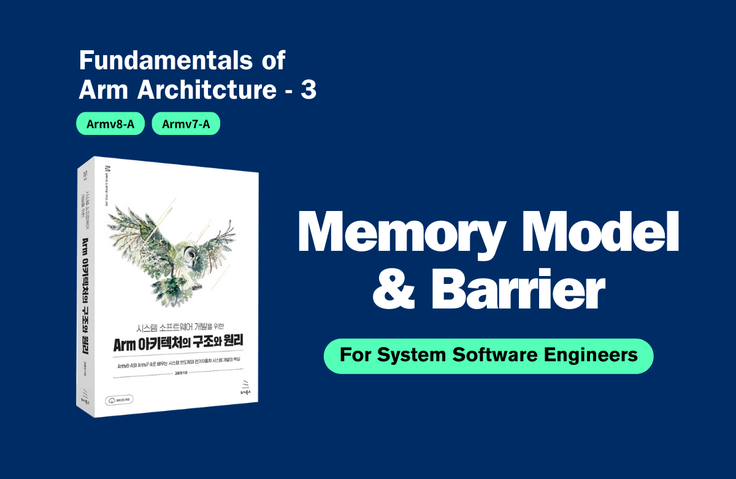
디버깅으로 배우는 RISC-V 아키텍처 - 3부
김동현 (Austin Kim)
오픈 소스 기반의 최신 CPU 아키텍처인 RISC-V의 핵심 개념과 실용적인 팁을 쉽고 상세하게 설명합니다.
초급
cpu, cpu-architecture, riscv
The author of "Arm Architecture Structure and Principles for System Software Development" will properly address 'Memory Model and Barrier,' the very fundamentals of system software and core to the latest Arm architectures (Armv8-A, Armv7-A)!
112 learners

You can understand the basic operating principles of the memory model and barriers in Arm architecture (Armv8-A).
Learn how Arm architecture's memory model and barrier features are applied in real projects.
You can get an overview of the execution flow and structure related to memory models and barriers.
I can answer memory model and barrier interview questions well.
Who is this course right for?
Junior developer who wants to grow skills in the system software field, including system semiconductor (fabless) and electric vehicle sector (autonomous driving, infotainment)
Aspiring system software developer for system semiconductor (fabless) and electric vehicle fields
System software developer (system semiconductors, electric vehicles) interested in how to debug in practice using Arm architecture's capabilities.
Need to know before starting?
Computer Architecture
Operating System
6,064
Learners
210
Reviews
89
Answers
4.9
Rating
22
Courses
글로벌 저자 & 리눅스 시스템 소프트웨어 개발자 (Arm, RISC-V 아키텍처)
국내 시스템 소프트웨어 분야에서 전무후무한! 'Arm 아키텍처(Armv8-A, Armv7-A)'와 '리눅스 커널' 책을 쓴 저자(2권의 책 모두 대한민국 학술원 우수도서에 선정)이며, 국내 최초로 해외 출판사(Packt)를 통해 "Reverse Engineering Armv8-A Systems" 책(영어)을 집필한 글로벌 저자입니다. 무엇보다 최신 시스템 소프트웨어 트렌드(전기자동차, 시스템 반도체- 시스템 소프트웨어)를 가장 잘 알고 있는 현업 개발자입니다. 또한 시스템 소프트웨어 분야에서 가장 지식 전파 활동을 활발하게 하는 교육자입니다.
'Reverse Engineering Armv8-A Systems: A practical guide to Kernel, Firmware, and TrustZone analysis' 책(영어) 저자, (Packt 출판사)
'시스템 소프트웨어 개발을 위한 Arm 아키텍처의 구조와 원리'(2024년, 대한민국 학술원 우수도서상) 저자
'디버깅을 통해 배우는 리눅스 커널의 구조와 원리' (2021년, 대한민국 학술원 우수도서상) 저자
'프로그래머스 데브 코스: 리눅스 시스템 및 커널 전문가' 메인 강사
2022년 6월, 한국컴퓨터종합학술대회 (KCC2022) - 튜토리얼 발표 [ftrace를 이용해 리눅스 커널 정복하기]
LG전자 '리눅스 커널' 및 'Armv8 아키텍처' 사내 강사(국내 및 해외 개발자 포함) - (2020년~현재)
국내에서 어느 누구보다 리눅스 커널과 Arm 아키텍처(Armv8-A, Armv7-A)를 잘 설명할 수 있는 교육자라고 자신있게 말씀드릴 수 있습니다.
강의문의 : austindh.kim@gmail.com
'시스템 소프트웨어 개발자를 위한 Arm - basic course'
All
27 lectures ∙ (3hr 50min)
All
6 reviews
4.8
6 reviews
$26.40
Check out other courses by the instructor!
Explore other courses in the same field!